Alleged proofs of their own innocence presented by the Kremlin do not stand up to scrutiny.
A serial number on the remains of the rocket is said to be one of the supposed proofs: Russia wants to wash its hands of the devastating attack last Friday in Kramatorsk in eastern Ukraine. Moscow and pro-Russian activists are currently trying to portray the attack on a train station that killed at least 50 as an action controlled by Kyiv.
The allegations in the fact check:
The rocket guy
- Claim: The Tochka-U missiles, whose wreckage was found near the station, would only be used by Ukrainian armed forces.
- Valuation: Not correct. Russia and its ally Belarus also use Tochka-U missiles.
- Facts: Kyiv and Moscow are now blaming each other for the deadly rocket attack on the Kramatorsk train station. Initially, several pro-Kremlin channels on Telegram and the Ministry of Defense had complained about the attack on the train station for Russia. Only shortly afterwards did they delete or edit their statements and switch to their current position.
One thing is certain: a Totschka-U version 9K79-1 was used in the attack. Several states of the former Soviet Union, including Ukraine and Belarus, have this type of missile, introduced in the 1980s.
True, the Russian army officially replaced its arsenal with the newer Iskander. However, in the Ukraine war there are several pieces of evidence that Moscow is still using the Tochka-U. According to the aid organization Amnesty International, a Russian attack with this type of rocket on a hospital in Wuhledar took place on the first day of the war. There are also reports of sightings of Russian Tochka submarine missiles in Ukraine. According to the findings of the US think tank Institute for the Study of War, a Russian unit deployed in the Donbass is equipped with it.
The “Ukrainian” serial number
- Claim: The missile can be traced back to the Ukrainian army based on the serial number on the Tochka submarine.
- Valuation: Not correct.
- Facts: Serial numbers were assigned during production in Soviet times. The projectiles are now old and stored in several countries of the former Eastern Bloc and in Syria, for example. There is no convincing evidence to support the claim that the order of the serial numbers was followed during distribution – as pro-Russian activists claim.
“After the collapse of the USSR, there is a ‘black hole’ of a few years with no information on which missiles remained in which countries, or which systems returned to Russia,” explains Lieutenant Colonel Frederik Coghe of the Royal Military Academy in Brussels the German Press Agency (dpa). “Serial numbers mean nothing without the lists of which serial numbers are in which countries.”
Even consecutive numbers don’t necessarily have to belong to the same countries, says Coghe. There could be the 13 in the Ukrainian, the 14 in the Belarusian and the 15 in the Russian arsenal. According to Coghe, it was a coincidence which country received which serial numbers.
 REUTERS / STRINGER
REUTERS / STRINGERThe traces at the site
- Claim: The remains of the missile on the ground allow the unequivocal conclusion that the Tochka-U was fired from Ukrainian-controlled territory.
- Valuation: This cannot be read unequivocally.
- Facts: The proponents of this claim argue with ballistics. The Rocket Engine is less than 100 meters southwest of Kramatorsk Train Station. Some conclude that the rocket should therefore have been launched from that direction as well. Those areas are under the control of Ukrainian forces.
A ballistic missile like the Totschka-U only accelerates in the initial phase and then flies towards the target without power. In doing so, it falls as a whole from a great height onto the programmed target. At a little more than 2000 meters above the ground, the fuse in the warhead of the Totschka-U is activated, as the Munich rocket technology expert Markus Schiller explains to the German press agency (dpa). The tip of the rocket bursts and around 50 individual charges – also called cassettes – and the burned-out rest of the rocket fall to the ground.
While the aerodynamic missile has flown stably up to that point, the remaining missile body loses this property after the detonation at the warhead. “He sails about two kilometers down like a leaf,” explains Schiller. Although the flight direction is probably still approximately maintained due to inertia, the tail can drift away in all directions. “So I would be very careful about drawing deep conclusions about the direction of flight from the position of the impacted missile body.”
Lieutenant Colonel Coghe also underscores this. After the detonation in the air, the rocket body probably follows its original trajectory. “Exactly how far it flies depends on the height of the detonation and the type of ammunition the rocket is loaded with,” says the expert from Belgium. It is true that a line can be drawn between the point of impact of the body and the combat objective, which indicates the direction. “But that’s not an exact science.”
The Totschka-U 9K79-1 can have a range of up to 120 kilometers. Even if it were shot down south to southwest of Kramatorsk, there are Russian occupied areas within range as well. The city of Donetsk is located in the south, 80 kilometers as the crow flies. And areas roughly west of Donetsk were also under the influence of the Kremlin on April 8.
This means: From the location of the remains on the ground alone, it cannot be concluded with absolute certainty that the missile was necessarily fired by Ukrainian forces.
